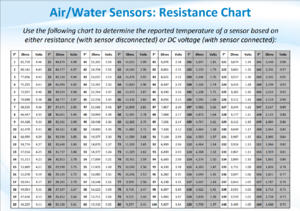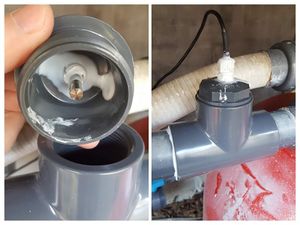| (One intermediate revision by the same user not shown) | |||
| Line 1: | Line 1: | ||
=Temperature Sensors= | =Temperature Sensors= | ||
==Standard 10K Thermistors== | ==Standard 10K Thermistors== | ||
| − | Temperature sensors for Pentair, Hayward, Jandy, and other pool automation systems are usually standard 10K ohm thermistor sensors. They are used for air, water, and solar temperatures. | + | Temperature sensors for Pentair, Hayward, Jandy, and other pool automation systems are usually standard 10K ohm NTC thermistor sensors. They are used for air, water, and solar temperatures. |
| + | |||
| + | NTC means negative temperature coefficient and is the type of sensor used. This means the resistance goes down as the temperature goes up. All the automation systems use the same sensor and if you look at the resistance verses temperature chart you will see that at 76 degrees Fahrenheit (25 degrees C) the sensor value is 10k ohms and the resistance drops with increasing temperature.<ref> https://www.troublefreepool.com/threads/jandy-temp-sensors.249364/post-2184386 </ref> | ||
The temperature sensor is typically mounted in a hole drilled into the PVC pipe and then secured with a band clamp around the pipe and sensor. | The temperature sensor is typically mounted in a hole drilled into the PVC pipe and then secured with a band clamp around the pipe and sensor. | ||
| Line 17: | Line 19: | ||
[[File:10K thermistor chart.png|thumb]] | [[File:10K thermistor chart.png|thumb]] | ||
| + | |||
| + | ===Shorted Water Temperature Sensor=== | ||
| + | |||
| + | The housing covering all temperature sensors is plastic. They can get cracks, large or small, that allow water in. Enough water will read as a short at times. When it dries the "short" goes away.<ref>https://www.troublefreepool.com/threads/jandy-aqualink-thermometer.251511/post-2201715</ref> | ||
==Pentair Compool== | ==Pentair Compool== | ||
Latest revision as of 00:33, 10 May 2022
Temperature Sensors
Standard 10K Thermistors
Temperature sensors for Pentair, Hayward, Jandy, and other pool automation systems are usually standard 10K ohm NTC thermistor sensors. They are used for air, water, and solar temperatures.
NTC means negative temperature coefficient and is the type of sensor used. This means the resistance goes down as the temperature goes up. All the automation systems use the same sensor and if you look at the resistance verses temperature chart you will see that at 76 degrees Fahrenheit (25 degrees C) the sensor value is 10k ohms and the resistance drops with increasing temperature.[1]
The temperature sensor is typically mounted in a hole drilled into the PVC pipe and then secured with a band clamp around the pipe and sensor.
Temperature sensors in other pool equipment also use 10K thermistors, including:
- Pentair IntelliChlor - the Harwil Q-12DST-C2 in it has an integrated 10k thermistor.
- Pentair MasterTemp Heaters
- Hayward Aquarite SWG - used for calculating salinity and detecting high or low temperatures.[2]
- Intex Pure Spa[3]
Testing
The sensor can be tested with a multimeter. It should read 10,000 ohms at 77F (25C) degrees. You can lookup other test values in the Temperature vs Resistance Conversion Chart for 10k Thermistors.
To test the device a 10K ohm resistor can be plugged in in-place of the thermistor cable and the device should read it as 77F (25C) degrees.
Shorted Water Temperature Sensor
The housing covering all temperature sensors is plastic. They can get cracks, large or small, that allow water in. Enough water will read as a short at times. When it dries the "short" goes away.[4]
Pentair Compool
The Pentair Compool, and LX80 Control Systems use a different TS5L sensor.
The Compool temperature display can be calibrated by:
- Press the Program key.
- Press the Spa Heat Source key.
- Enter correct pool temperature (using the up and down arrow keys) and press Spa Heat Source key.
At this point, you can just hit the Program key and exit calibration.
- Enter correct solar temperature and press Spa Heat Source key.
- Enter correct air temperature and press Spa Heat Source key.
- Enter number of days between backwash and press Spa Heat Source key.
- Enter number of minutes to backwash and press Spa Heat Source key.
- Enter floor cleaner valve cycle time and press Spa Heat Source key.
- Press the Program key to end.
Home Automation Temperature Sensors
There are many other types of automation systems with temperature probes that members have connected to their pool system. In one instance it was a waterproofed DS18B20 temperature probe connect via a Zwave receiver.[5] In another it was a Sonoff sensor with a TH16 temperature probe.[6]
These type of temperature probes are best secured using a PVC T union. The two ends of the T will match your pipe size (ex., 2” glue joint) and the center of the T will be a smaller diameter threaded pipe connection, ex., 3/4 female pipe thread.[7]
Next, get a 3/4” male threaded plug and drill a hole into the top of it. Put the thermistor in the hole and pot it with a thick blob of epoxy. Thermistors are cheap as are PVC pipe plugs so just make a bunch of them.
Screw the plug into the T with some pipe tape or liquid Teflon tape (or both) and you’ve got yourself a solid connection that is easily replaceable in the event the temp sensor dies.
You can also cut a thread with a tap and use an IP68 coupling of some sort that fits very tight to the probe and secure it with some glue
Hayward Pool Boss system
The temp sensors (PSC2023 and PSC2022) on the Hayward Pool Boss system are not 10K thermistors.[8] They are Negative Temperature Coefficient (NTC) thermistor where the resistance goes up when the temperature goes down. The span of readings at normal pool temperatures is more than 200K Ohms.[9]
Hayward said the unit was made by Balboa. The Balboa M7 unit looks almost exactly like a direct replacement for the PSC2022 Hayward part except that the wire is 2 feet long instead of 20 feet long.[10]
The Balboa 25-175-0337 is a combined water and air temp sensor with two wires zip-tied together at the board plug end and two probes that look suspiciously just like the Hayward parts. Both of these sensors work and track temps just like the Hayward parts.
- ↑ https://www.troublefreepool.com/threads/jandy-temp-sensors.249364/post-2184386
- ↑ https://www.troublefreepool.com/threads/how-to-use-my-own-power-supply-for-aquarite-salt-cell.169333/post-1519080
- ↑ https://www.troublefreepool.com/threads/intex-pure-spa-e95-code-i-need-help.114669/post-1390103
- ↑ https://www.troublefreepool.com/threads/jandy-aqualink-thermometer.251511/post-2201715
- ↑ https://www.troublefreepool.com/threads/attaching-temp-sensor-in-pvc-pipe.157764/post-1396828
- ↑ https://www.troublefreepool.com/threads/attaching-temp-sensor-in-pvc-pipe.157764/post-1739504
- ↑ https://www.troublefreepool.com/threads/attaching-temp-sensor-in-pvc-pipe.157764/post-1396834
- ↑ https://www.troublefreepool.com/threads/how-to-use-my-own-power-supply-for-aquarite-salt-cell.169333/post-1519071
- ↑ https://www.troublefreepool.com/threads/hayward-2100-temperature-sensor-problem.69428/post-985929
- ↑ https://www.troublefreepool.com/threads/hayward-2100-temperature-sensor-problem.69428/post-1589195



